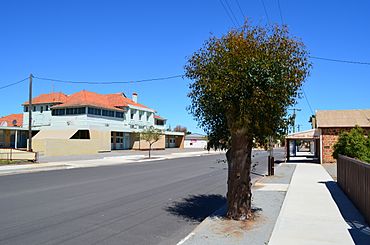Carnamah, Western Australia facts for kids
Quick facts for kids CarnamahWestern Australia |
|||||||||
|---|---|---|---|---|---|---|---|---|---|

Macpherson Street, Carnamah, 2012.
|
|||||||||
| Established | 1913 | ||||||||
| Postcode(s) | 6517 | ||||||||
| Elevation | 273 m (896 ft) | ||||||||
| Area | [convert: needs a number] | ||||||||
| Location |
|
||||||||
| LGA(s) | Shire of Carnamah | ||||||||
| State electorate(s) | Moore | ||||||||
| Federal Division(s) | Durack | ||||||||
|
|||||||||
Carnamah is a small town located in the Mid West region of Western Australia. It's about 307 kilometers (191 miles) north of Perth. According to the 2021 census, about 407 people live in Carnamah.
The town was officially named in 1913. Its name comes from "Carnamah", a large farm property started by Duncan Macpherson in the late 1860s. A telegraph station was set up here in 1873. The name "Carnamah" likely comes from an Aboriginal word. It might also be a Gaelic word meaning "cattle rocks".
The main job in Carnamah is wheat farming. The town is an important place where farmers bring their harvested wheat.
Discovering Carnamah
Carnamah's Early Days
The Midland Railway line was built through this area in 1894. A train stop was made near Macpherson's farm. This helped more people move to the area and settle down.
In 1912, the Carnamah Progress Association was formed. This group worked to improve the town. The Carnamah State School was also opened. Then, in 1913, Carnamah was officially declared a town.
Later, in 1932, a group called the Wheat Pool of Western Australia decided to build two large grain elevators in Carnamah. These elevators, powered by engines, helped store and move the wheat from the railway.
Carnamah's Climate
Carnamah has a hot, dry climate, which is called a hot semi-arid climate. This means it has very hot, dry summers and mild, somewhat rainy winters.
In January, the average high temperature is about 36.0°C (96.8°F). In July, the average high is around 17.9°C (64.2°F). The lowest temperatures usually happen in August, averaging about 7.2°C (45.0°F).
The town doesn't get a lot of rain, averaging about 376.0 millimeters (14.8 inches) each year. Most of the rain falls during the winter months. Carnamah is a very sunny place, with many clear days throughout the year.
The hottest temperature ever recorded in Carnamah was 48.1°C (118.6°F) in January 1980. The coldest was -2.2°C (28.0°F) in July 1948.
| Climate data for Carnamah (29°41′S 115°53′E / 29.69°S 115.89°E, 268 m AMSL) (1940-2024 normals & extremes, rainfall to 1887) | |||||||||||||
|---|---|---|---|---|---|---|---|---|---|---|---|---|---|
| Month | Jan | Feb | Mar | Apr | May | Jun | Jul | Aug | Sep | Oct | Nov | Dec | Year |
| Record high °C (°F) | 48.1 (118.6) |
48.0 (118.4) |
43.9 (111.0) |
40.0 (104.0) |
35.5 (95.9) |
29.0 (84.2) |
27.8 (82.0) |
31.4 (88.5) |
35.1 (95.2) |
41.7 (107.1) |
43.2 (109.8) |
45.3 (113.5) |
48.1 (118.6) |
| Mean daily maximum °C (°F) | 36.0 (96.8) |
35.6 (96.1) |
32.7 (90.9) |
27.6 (81.7) |
22.5 (72.5) |
19.0 (66.2) |
17.9 (64.2) |
19.2 (66.6) |
22.0 (71.6) |
26.1 (79.0) |
30.0 (86.0) |
33.5 (92.3) |
26.8 (80.3) |
| Mean daily minimum °C (°F) | 18.5 (65.3) |
19.3 (66.7) |
17.4 (63.3) |
14.1 (57.4) |
10.8 (51.4) |
8.7 (47.7) |
7.3 (45.1) |
7.2 (45.0) |
8.2 (46.8) |
10.4 (50.7) |
13.4 (56.1) |
16.1 (61.0) |
12.6 (54.7) |
| Record low °C (°F) | 3.3 (37.9) |
6.9 (44.4) |
2.8 (37.0) |
1.7 (35.1) |
1.1 (34.0) |
−0.6 (30.9) |
−2.2 (28.0) |
0.6 (33.1) |
1.1 (34.0) |
1.1 (34.0) |
2.3 (36.1) |
6.7 (44.1) |
−2.2 (28.0) |
| Average precipitation mm (inches) | 12.7 (0.50) |
15.9 (0.63) |
20.1 (0.79) |
22.5 (0.89) |
49.1 (1.93) |
73.2 (2.88) |
66.7 (2.63) |
51.8 (2.04) |
27.4 (1.08) |
16.2 (0.64) |
10.6 (0.42) |
8.5 (0.33) |
376.0 (14.80) |
| Average precipitation days (≥ 0.2 mm) | 2.0 | 2.1 | 2.8 | 4.5 | 8.7 | 12.2 | 13.8 | 11.7 | 8.1 | 5.1 | 2.9 | 1.8 | 75.7 |
| Average afternoon relative humidity (%) | 26 | 28 | 31 | 39 | 46 | 51 | 56 | 51 | 46 | 33 | 28 | 27 | 39 |
| Average dew point °C (°F) | 10.9 (51.6) |
11.4 (52.5) |
10.9 (51.6) |
10.8 (51.4) |
9.1 (48.4) |
7.6 (45.7) |
7.9 (46.2) |
7.1 (44.8) |
7.5 (45.5) |
6.9 (44.4) |
7.7 (45.9) |
9.6 (49.3) |
9.0 (48.1) |
| Source: Bureau of Meteorology (1940-2024 normals & extremes, rainfall to 1887) | |||||||||||||


